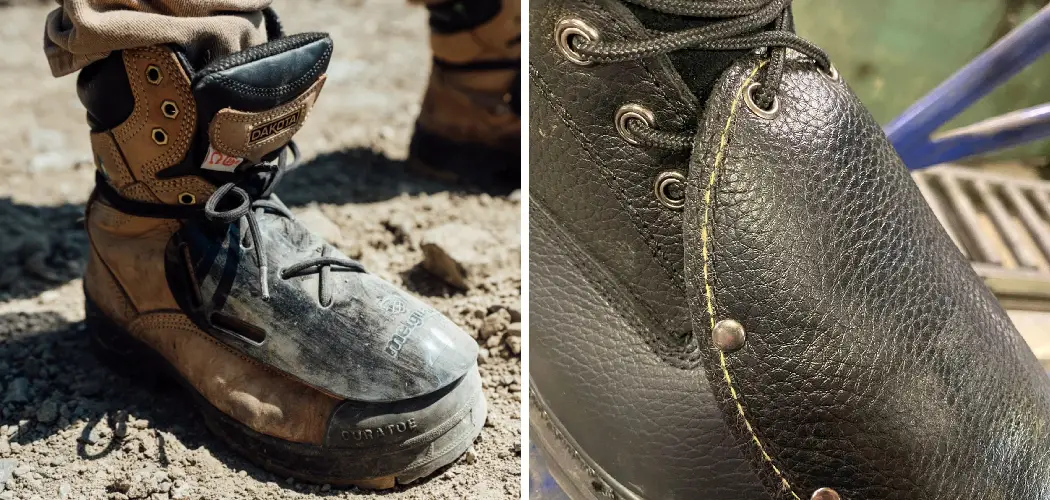Adding met guards to your boots can be a simple and effective way to provide extra protection for your feet. Whether you work in construction, industrial settings, or any other job that requires safety equipment, having met guards on your boots can help prevent injuries and keep you safe while on the job.
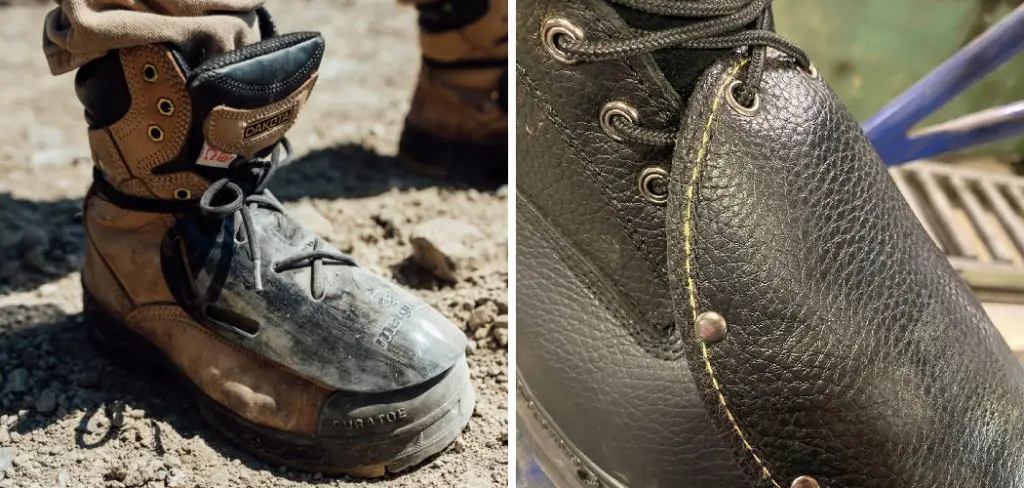
In this guide on how to put met guards on boots, we will discuss the steps you need to follow in order to properly put met guards on your boots.
What are Met Guards?
Met guards, also known as metatarsal guards, are protective devices that cover the top of your foot and provide extra protection for your metatarsal bones. These bones are located in the middle part of your foot and are prone to injuries from falling objects or heavy equipment.
Necessary Items
Before you begin the process of putting met guards on your boots, make sure you have all the necessary items. These include:
- Met Guards: Choose a pair that fits your boot size and provides adequate coverage for your metatarsal bones.
- Boots: Make sure your boots are clean and in good condition before adding met guards.
- Adhesive: Depending on the type of met guards you have, you may need adhesive to attach them to your boots.
- Scissors: You may need to trim the met guards to fit properly on your boots.
12 Steps on How to Put Met Guards on Boots
Step 1: Clean Your Boots
Make sure your boots are clean and free of any dirt or debris. This will ensure that the adhesive sticks properly to the surface. If you are using adhesive-free met guards, having clean boots will prevent any interference with the adhesive strips on the met guards.
Step 2: Prepare the Met Guards
If your met guards require adhesive, make sure to apply it according to the manufacturer’s instructions. Some may require you to peel off a backing or activate the adhesive by pressing it against a surface.
Step 3: Determine Placement
Before attaching the met guards, determine the best placement on your boots. They should cover the entire top part of your foot, including your toes and metatarsal bones. As a general rule, the met guards should start just above your toes and end at the top of your foot.
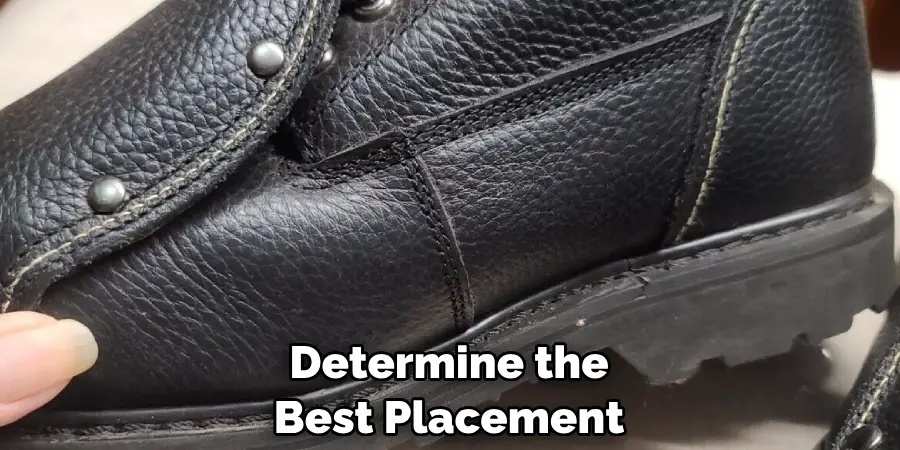
Step 4: Trim if Necessary
If your met guards are too large for your boots, use scissors to trim them down to the appropriate size. Make sure to follow any guidelines provided by the manufacturer to ensure proper fit and coverage.
Step 5: Attach the Met Guards
Carefully place the met guards on your boots, making sure they are evenly centered and aligned with the toes and top of your foot. Evenly press down on the met guards to ensure they are securely attached.
Step 6: Check for Comfort
Take a few steps in your boots to make sure the met guards feel comfortable and do not cause any discomfort or rubbing. If necessary, adjust the placement or trim any excess material. While met guards are meant to provide protection, they should still be comfortable to wear.
Step 7: Allow Adhesive to Set
If you are using adhesive to attach your met guards, allow them to set for the time specified by the manufacturer before wearing your boots. This will ensure that the met guards stay securely attached.
Step 8: Alternative Placement
While placing met guards on top of your boots is the most common method, you may also choose to place them inside your boots. This can provide additional protection for your feet and leave the exterior of your boots looking clean.
Step 9: Follow Manufacturer’s Instructions
Always follow the instructions provided by the manufacturer when putting on met guards. They may have specific guidelines or tips for proper attachment and maintenance. Even if you have experience with putting on met guards, it’s important to review the instructions each time.
Step 10: Maintain Met Guards
Regularly check your met guards for any signs of wear or damage. Replace them as needed to ensure ongoing protection for your feet. If using adhesive, make sure to clean off any dirt or debris that may interfere with its effectiveness.
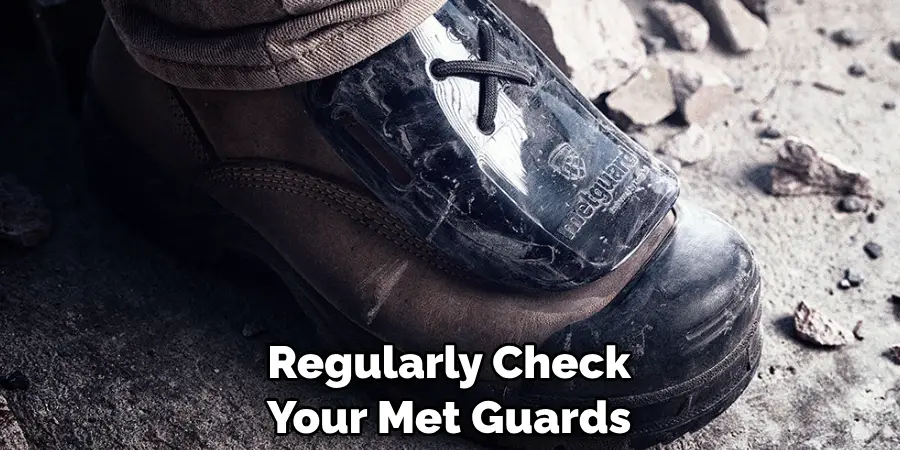
Step 11: Wear Properly Fitting Boots
Having boots that fit properly is essential for ensuring the effectiveness of met guards. Make sure your boots are not too loose or too tight, and consider adding insoles for extra comfort and support. Other safety equipment, such as steel-toe caps, should also be worn with met guards for full protection.
Step 12: Educate Others
If you work in an industry where met guards are necessary, make sure to educate others on the importance of wearing them and how to properly put them on. This can help prevent injuries and promote a safe working environment for everyone.
Adding met guards to your boots is a simple and effective way to provide extra protection for your feet. By following these steps, you can easily put met guards on your boots and ensure they are properly attached and comfortable to wear. Remember to always follow the manufacturer’s instructions and properly maintain your met guards for ongoing protection.
9 Safety Measures to Take When Wearing Met Guards
While met guards can provide extra protection, it’s important to also take other safety measures when wearing them. These include:
1) Wearing Proper Fitting Boots
As mentioned in Step 11, having boots that fit properly is crucial for ensuring the effectiveness of met guards. Loose or tight-fitting boots can cause discomfort and may interfere with the placement and functionality of met guards.
2) Using Other Safety Equipment
Met guards are just one piece of safety equipment that can help protect your feet on the job. Make sure to also wear steel-toe caps, protective eyewear, and any other necessary equipment for your specific industry.
3) Regularly Checking Boots and Met Guards
Take the time to regularly check your boots and meet guards for any signs of wear or damage. This will ensure they are still providing proper protection and allow you to replace them as needed.
4) Educating Others
Not only should you educate others on how to properly put on met guards, but also on the importance of wearing them and other safety measures. This can help promote a safe working environment for everyone.
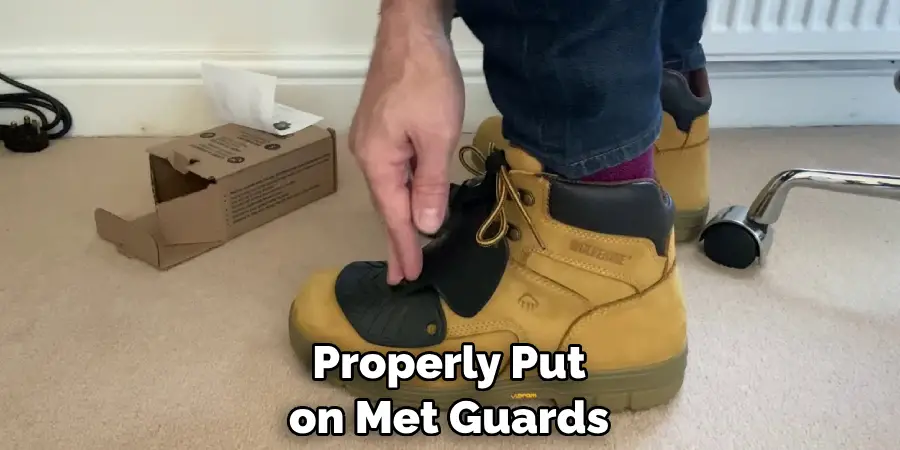
5) Maintaining a Safe Work Environment
In addition to personal protective equipment, it’s important to also maintain a safe work environment. This includes keeping work areas clean and free of hazards, following safety protocols, and properly training employees.
6) Staying Alert and Focused
Pay attention to your surroundings and stay alert while wearing met guards. This can help prevent accidents and injuries caused by distractions or lack of focus. And if you do notice any potential hazards, report them immediately to the proper authorities.
7) Taking Breaks When Needed
Working long hours in uncomfortable boots with met guards can take a toll on your feet. Make sure to take breaks when needed and give your feet a chance to rest and recover. Keep in mind properly fitting boots and insoles can also help reduce fatigue.
8) Properly Cleaning and Maintaining Met Guards
As mentioned in Step 10, regularly cleaning and maintaining your met guards is important for their effectiveness. This includes removing any dirt or debris that may interfere with the adhesive and replacing them as needed.
9) Seeking Medical Attention if Injured
If you do happen to suffer an injury while wearing met guards, seek medical attention immediately. This will ensure proper treatment and prevent further complications. And if necessary, make sure to follow up with your employer for any necessary paperwork or workers’ compensation claims.
By taking these additional safety measures on how to put met guards on boots, you can help ensure the effectiveness of met guards and promote a safe working environment for yourself and others. Remember, it’s important to always prioritize safety on the job and take necessary precautions to protect yourself from potential hazards. Overall, adding met guards to your boots and following these guidelines can help prevent injuries and promote a safer workplace.
8 Things to Avoid When Wearing Met Guards
While wearing met guards can provide extra protection, there are some things you should avoid to ensure their effectiveness. These include:
1) Improper Placement
As mentioned in Step 3, it’s important to properly place met guards on top of your boots and secure them according to the manufacturer’s instructions. Avoid placing them too high or too low, as this can interfere with their ability to protect your feet.
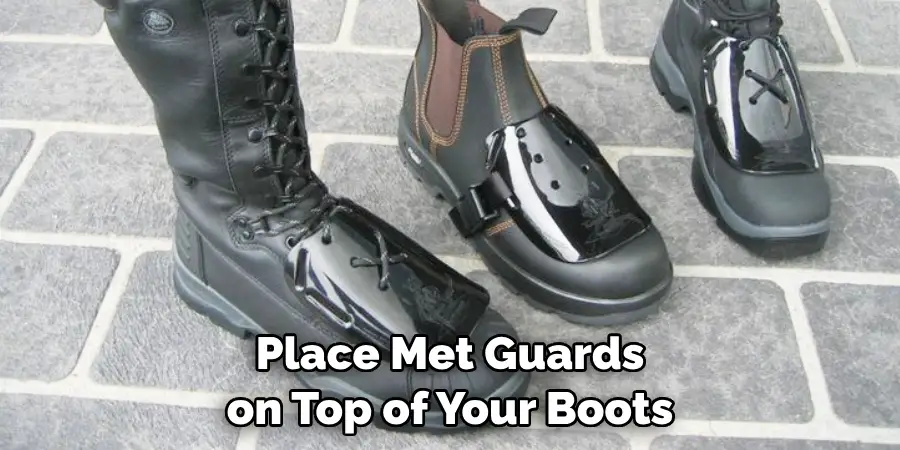
2) Wearing Damaged or Worn Out Met Guards
Regularly check your met guards for any signs of wear or damage and replace them as needed. Continuing to wear damaged or worn-out met guards will not provide proper protection and may even cause further injury.
3) Using Adhesive on Dirty or Wet Boots
If using adhesive to attach met guards, make sure your boots are clean and dry before applying. Dirt or moisture can interfere with the effectiveness of the adhesive and cause the met guards to not stay in place.
4) Not Wearing Other Necessary Safety Equipment
As mentioned in Step 2, wearing other necessary safety equipment is important when working in industries that require met guards. Avoid neglecting other protective gear, and make sure to follow all safety protocols.
5) Ignoring Signs of Discomfort
If you notice any discomfort or pain while wearing met guards, don’t ignore it. This could be a sign that your boots or met guards are not properly fitted and may need adjustment. Other factors, such as long hours on your feet, can also contribute to discomfort and should be addressed.
6) Not Regularly Cleaning and Maintaining Met Guards
As mentioned in Step 10, regularly cleaning and maintaining met guards is important for their effectiveness. Avoid neglecting this task and make sure to properly clean and replace them as needed. If using adhesive, also make sure to follow the manufacturer’s instructions for removal and application.
7) Forgetting to Educate Others
In addition to educating others on the importance of wearing met guards, it’s also important to educate them on what not to do. Make sure everyone in your workplace knows how to properly wear and maintain met guards for their own safety.
8) Not Seeking Medical Attention for Injuries
If you do happen to suffer an injury while wearing met guards, don’t ignore it or try to tough it out. Seek medical attention immediately and make sure to follow any necessary treatment plans. This will ensure proper healing and prevent further complications.
By avoiding these things, you can help ensure the effectiveness of your met guards and promote a safer working environment for yourself and others. Remember, taking these precautions is crucial in preventing injuries on the job. Always prioritize safety and follow proper procedures when using met guards.
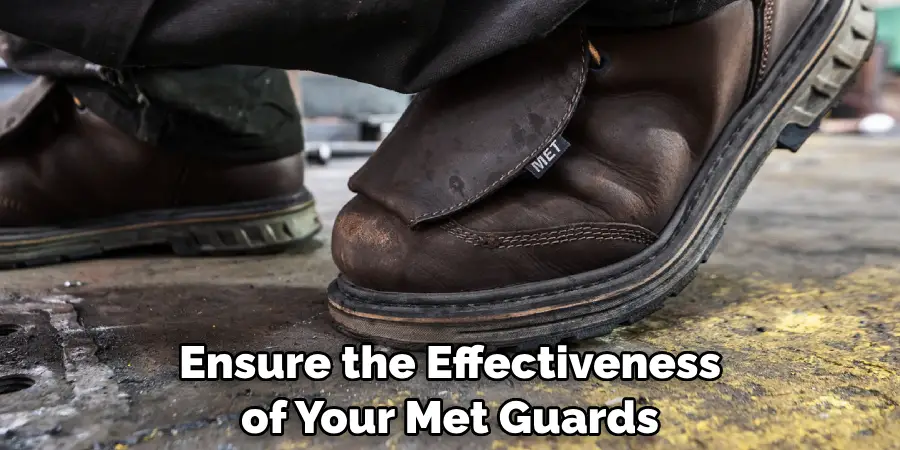
8 Additional Tips for Wearing Met Guards
Here are some additional tips to keep in mind when wearing met guards:
1) Choose the Right Type of Met Guard
There are different types of met guards available, such as external and internal. Consider your job requirements and personal comfort when choosing the right type for you. Even within those categories, there are various styles and materials to choose from.
2) Invest in Quality Met Guards
While it may be tempting to go for the cheapest option, investing in quality met guards can provide better protection and longer-lasting durability. This can save you money in the long run and ensure your safety on the job.
3) Wear Properly Fitted Boots
As mentioned in Step 4, properly fitting boots is crucial when wearing met guards. Make sure to choose boots that fit comfortably and provide proper support for your feet. Soles and insoles can also make a difference in fit and comfort.
4) Take Breaks When Needed
As mentioned in Step 11, taking breaks when needed and giving your feet a chance to rest can help reduce fatigue and prevent injury. Don’t push yourself too hard, and listen to your body’s signals for rest.
5) Consider Rotating Met Guards
If you have multiple pairs of boots, consider rotating your met guards between them. This can give each pair a chance to dry out and prevent the buildup of bacteria or moisture. As a bonus, it can also extend the life of your met guards.
6) Follow the Manufacturer’s Instructions
Whether it’s for wearing, cleaning, or maintaining your met guards, make sure to follow the manufacturer’s instructions. They know their product best and can provide specific guidelines for proper use.
7) Consider Custom Met Guards
If standard met guards don’t fit your feet properly, consider getting custom ones made. This can provide a more comfortable and secure fit for those with unique foot shapes or sizes. While they may be more expensive, they can provide better protection and prevent discomfort.

8) Stay Informed on Industry Guidelines
As with any safety equipment, it’s important to stay updated on industry guidelines and regulations for wearing met guards. This can help ensure you are following the necessary protocols for your specific job and industry.
By keeping these tips on how to put met guards on boots in mind, you can ensure proper use and maintenance of your met guards, leading to a safer and more productive work environment. Remember, the goal is to prevent injuries and promote safety for yourself and those around you. Stay informed, be proactive, and always prioritize safety when wearing met guards on the job. So go ahead and put on your guard with confidence!
Frequently Asked Questions
Can I Wear Met Guards With Any Boots?
It is recommended to wear met guards specifically designed for your type of boots. Some met guards may only be compatible with certain styles or brands of boots, so it’s important to check before purchasing.
Can I Clean My Met Guards With Any Cleaning Products?
It is best to follow the manufacturer’s instructions for cleaning and maintaining your met guards. Using harsh chemicals or abrasive materials can damage them and reduce their effectiveness. Even using the wrong type of adhesive can also affect their performance.
How Often Should I Replace My Met Guards?
It’s important to regularly inspect your met guards for any signs of wear and tear. If they are damaged or no longer provide proper protection, it is recommended to replace them immediately. Additionally, if you notice discomfort while wearing them, it may be a sign that they need to be replaced. As a general rule, it’s recommended to replace met guards every 6 months to a year, depending on usage and wear.
Can I Wear Met Guards in Cold Weather?
Yes, met guards can be worn in cold weather as long as they are properly fitted and compatible with your boots. Some met guards may also provide insulation for added warmth. However, it’s important to regularly check for ice or snow buildup on your met guards and clean them as needed to prevent slipping hazards.
Can I Wear Met Guards in Hot Weather?
Met guards can also be worn in hot weather, but taking breaks when needed and staying hydrated is important. Wearing breathable socks and choosing a more lightweight material for your met guards can also help keep your feet cool and comfortable. Additionally, it’s important to regularly check for any signs of heat-related discomfort or irritation while wearing met guards.
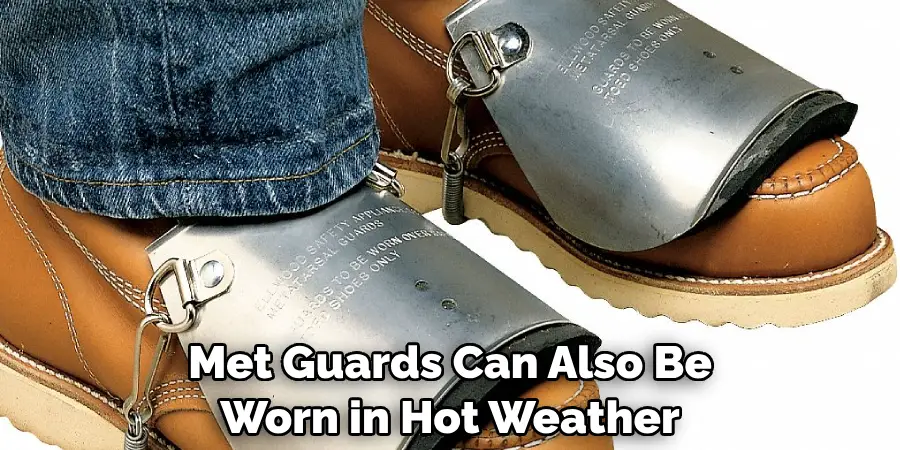
Conclusion
Met guards are an important safety measure in many industries, providing protection for the feet and toes from heavy objects and other hazards.
By understanding their purpose and proper usage, as well as following additional tips on how to put met guards on boots for wearing them, you can ensure maximum effectiveness and promote a safer working environment. Remember to prioritize safety at all times and stay informed on industry guidelines for wearing met guards.

